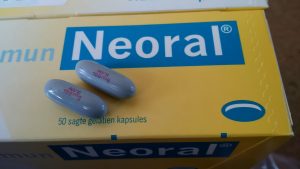
And nowhere is this more apparent than in the administering of immunosuppressant drugs.
When effective immunosuppressant treatment was presented to the world in the late 1970s, it constituted the single most important stabilizing agent in the nascent heart transplant programme initiated by Chris Barnard in 1967. But, by lowering the body’s immune system and limiting its potential to reject a foreign organ such as a transplanted heart, the positive (or, depending how you might see it, negative) effects of immunosuppressant drugs must also be counterbalanced.
These effects include the threat of infection from a wide variety of sources – contact with people, especially those who may be carrying an infection such as colds or flu, foods that have not been properly prepared or exposed (raw meats including biltong are a no-no, although South African transplant recipients speak openly about sneaking this national delicacy into their Saturday afternoon rituals), animal waste, over-exposure to the sun.
A particular concern is cytomegalovirus or CMV, a viral infection which many people have at some stage been exposed to but which can cause serious complications for organ recipients.
Apart from immunosuppressants like Cyclosporine and Advagraf, my daily drug regime includes long- and short-term medicines: Zaprine, which is used in conjunction with Cyclosporin; Prednisone, a steroid which also assists the anti-rejection process; Purbac, an antibiotic; Ecotrin, a low-level aspirin which reduces the risk of blood clots; Valcyte which acts against CMV infection; Crestor to manage cholesterol; Glucophage to treat my type 2 diabetes.
The known side effects of all these medicines are vast, some of a temporary nature, others for as long as one is on the medication.
Cyclosporin, the immunosuppressant drug which I started taking immediately upon the transplant, has side effects which include trembling hands, an increase in body hair, memory loss, sleep disturbances. Branded as Neoral and also known as (aka) Sandimmun & Gengraf, the dosage changes according to blood levels. Swollen gums, confusion or memory problems, abnormal kidney function, high blood pressure, diarrhea, vomiting & nausea, numbness & tingling in hands & feet are among the side effects.
Advagraf aka Tacrolimus, Astagraf XL, Envarsus XR, Hecoria, Prograf, Ponagraf, is another immunosuppressant introduced after three months to replace Cyclosporine. Its side-effects include decreased urine output as a result of kidney problems, high blood pressure, sleep disturbances, high blood sugar, numbness & tingling in hands & feet, tremors in hands, diarrhea & vomiting, headaches.
Zaprine, on the other hand, can cause hair loss (yes, the Lord gives hair and the Lord takes hair away). Aka Azathioprine or Imuran, Zaprine suppresses the immune system, assisting the main immunosuppressant. The dosage changes according to white cell count and can cause relatively low incidence of nausea, vomiting, fever, joint pains, abnormal liver function, and tumours.
Prednisone is a corticosteroid aka Trolic and is used to treat or prevent organ rejection. Side effects include upset stomach, increased appetite, weight gain, diabetes & cataracts, skin sensitivity, irritability, emotional sensitivity & depression, sleep disturbances, weakness of muscles & bones.
Purbac aka Bactrim or Cozole is a broad spectrum antibiotic to treat or prevent certain types of pneumonia.
Ecotrin aka Aspirin prevents blood clots.
Valcyte is an antiviral treatment for CMV or cytomegalovirus which can exhibit in fever, sore throat, fatigue & swollen glands after organ transplant. More serious CMV symptoms affect eyes, lungs, liver, oesophagus, stomach & intestines. Valcyte can contribute to kidney dysfunction, seizures, sleepiness, dizziness, unsteady movements, confusion, diarrhea, nausea, tremors.
Hi Ray,
Another side effect of Advagraf is itching and in some cases quite severe. This has affected me and quite a few other patience as well. It can take up to two months to fully subside.
Hi Mac, thanks for your contribution. I had not heard about this until you mentioned it in clinic. I guess one just needs to make a habit of reading the small print, and sharing with each other to further knowledge, hey? It’s obviously a challenge for the medical people to raise an alert against every issue when the way drugs react to each of us is also so much dependent on what our individual chemistry is. But isn’t it amazing how, when we sit in the clinic and share about the “worst” experiences we have had post-op, they all still pale into insignificance compared to the benefits we now have. Amazing grace!